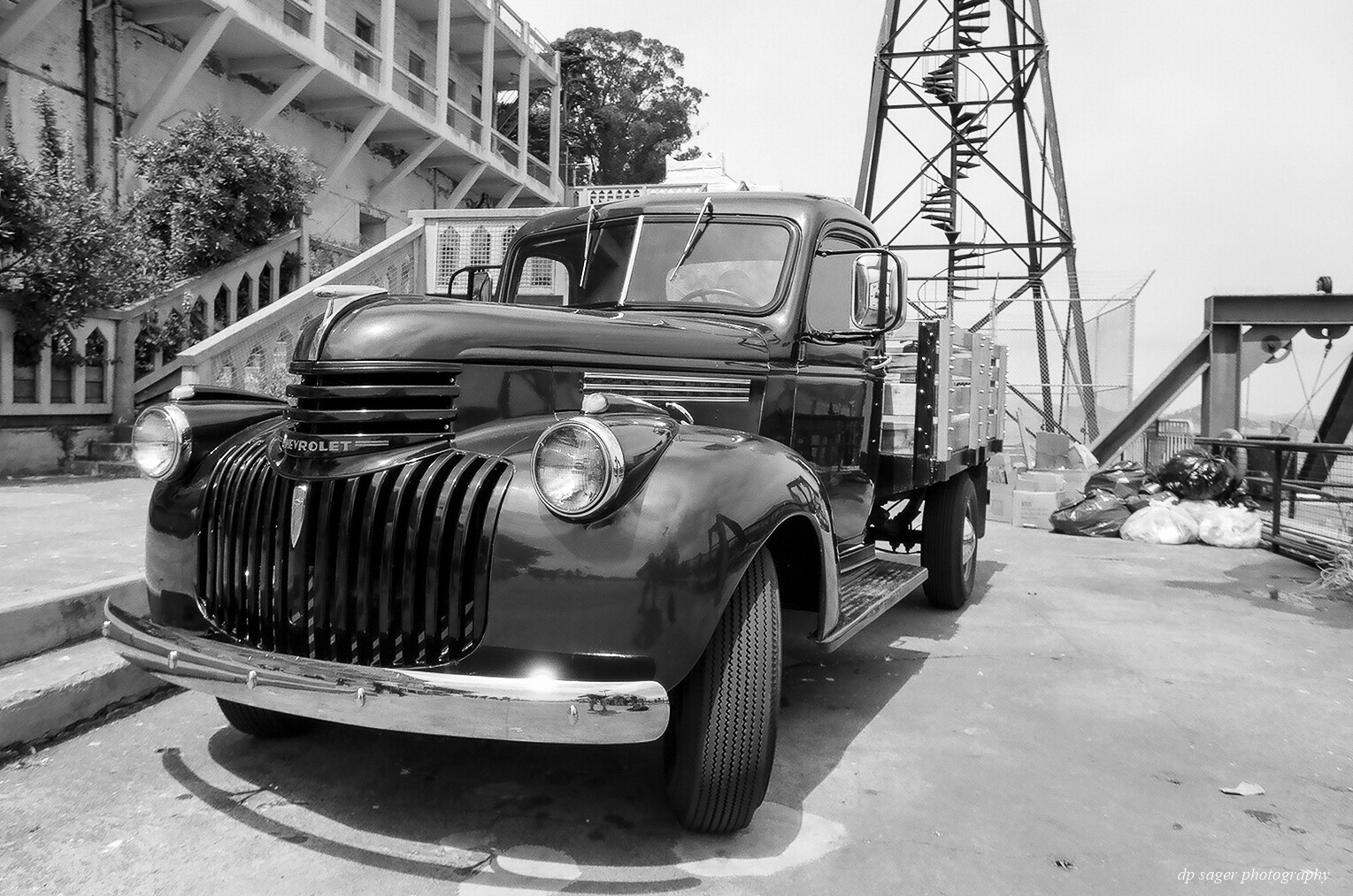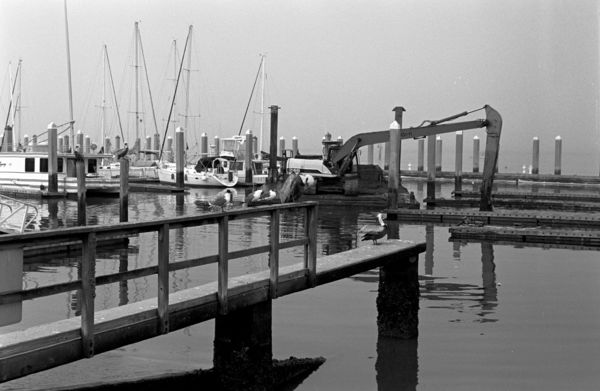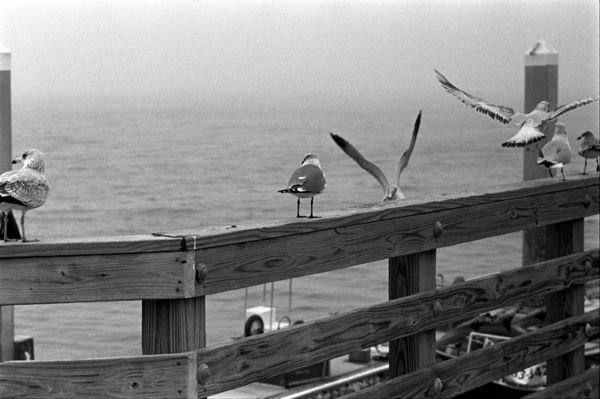Comparing TMAX 100 vs T-MAX 400
Mar 25, 2021 08:45:59 #
This post collects some comments from online sources and seeks to demonstrate those comments when looking at the details of two speeds of Kodak T-MAX films: TMAX 100 vs T-MAX 400. Other than the speed / sensitively of the film, what is the difference? Do those differences show in the results?
Part of my own "return to film" is exploring the different film types. Today's available film types are primarily premium emulsions, shot in premium cameras. For 35mm film, this common "full frame" format dates back to Kodak in 1934. As the popularity of handheld photography grew, along with available cameras, the 35mm format became the most popular photographic film size in the late 1960s. Kodak TMAX is a relatively recent release, dating to 1986.
For the term film 'emulsion', this refers to how the silver halide grains are suspended in a gelatin colloid. Different film types, aka stocks, use different shapes of the silver halide grains, creating different 'looks' in how the film looks in terms of sharpness and the tone of the black and white contrast of the image.
Example 1
Scanned from Kodak T-MAX 100 (shot at ISO 100)
EOS 1v, EF17-40mm f/4L USM, 1/160 sec at f/9, 25mm
Chevy Truck by Paul Sager, on Flickr

Kodak Professional T-MAX Film is a continuous tone, panchromatic, tabular-grain black and white negative film. T-MAX has a chemical makeup that was revolutionary for its time in the mid 80s. In the 1970s, a tabular grain (T-grain) was created to pack more chemicals onto the surface of the film emulsion, a critical need for color photography. Kodak was the first to use the same technology with black and white film, creating T-MAX. These tabular crystals gave T-MAX a sharper look and more contrast than any other black and white film then on the market. Current T-grain films include Ilford Delta, Fuji Acros, and Kodak T-MAX at 100, 400, and 3200.
As I scanned my Lightroom catalog for T-MAX examples, many of my favorite images were captured on T-MAX. This was an odd realization given how much I've been investigating and shooting other film types. All three of these current T-grain options (Delta, Acros, T-MAX) are my preferred films for sharpness and contrast.
Example 2
Scanned from Kodak T-MAX 100 (shot at ISO 100)
EOS 1v, EF100-400mm f/4.5-5.6L IS USM, 1/2000 sec at f/8
B&W Water lily

T-MAX is know for protecting highlights and providing a smoother transition to shadows. These examples demonstrate a few situation, including indoor light, outdoors sunlight and overcast snowstorms.
Example 3
Scanned from Kodak T-MAX 100 (shot at ISO 100)
EOS 1v, EF 50mm f/1.2L, 1/320 sec at f/5.6
Graceland Cemetery

T-MAX 100 is recommended for both indoors and outdoors at the ISO-100 box speed.
Example 4
Scanned from Kodak T-MAX 100 (shot at ISO 100)
EOS 1v, EF 50mm f/1.8, 1/60 sec at f/2
Alcatraz Federal Penitentiary

This post isn't intended to be a 1:1 compare of the two films. All of the contrast comes from the film and modest postprocessing. None include the use of colored filters.
Example 5
Scanned from Kodak T-MAX 100 (shot at ISO 100)
EOS 1v, EF16-35mm f/4L IS USM, 0.6 sec at f/7.1, 28mm
OCC B&W 2019

Hopefully, the differences of the two films are subtle, if at all, when looking at these scanned and processed images. The scanned JPEGs are all processed in Adobe Lightroom v6 and the posted JPEGs are resized to 1600-pixels wide to embed into this UHH post.
Example 6
Scanned from Kodak T-MAX 400 (shot at ISO 400)
EOS 1v, EF70-300mm f/4-5.6L IS USM, 1/6400 sec at f/5, 70mm
Old Ferris wheel

All these images have some amount of film grain. Online sources suggest shooting the 100 at the box speed, but adjusting the 400 speed between 320 and as much as 1-stop at ISO-200. This ISO-200 idea is shown in examples below as examples 11 and 12.
Example 7
Scanned from Kodak T-MAX 400 (shot at ISO 400)
EOS 1v, EF 35mm f/1.4L USM, 1/200 sec at f/5
Waiting for Spring

Kodak T-Max 400 film was revised in 2007 to the fine grain film available today.
Example 8
Scanned from Kodak T-MAX 400 (shot at ISO 400)
EOS 1v, EF 24-70mm f/2.8L II USM, 1/400 sec at f/7.1, 63mm
St Patrick's Parade

Kodak T-Max 400 is known for its fairly high contrast (in the highlights and shadows), its fine grain and its overall sharpness. Kodak literature claims its the sharpest black and white 400 speed film in the world.
Example 9
Scanned from Kodak T-MAX 400 (shot at ISO 400)
EOS 1v, EF 50mm f/1.8, 1/2000 sec at f/5.6
Fort Gaines

These next two images look at the same subject with the same lens, Chicago's Cloud Gate (aka The Bean), both in a winter snow, Feb 2015 and Jan 2021 respectively. Both use Kodak T-MAX 400, the first, example 10, at the ISO-400 box speed. Example 11 shows the ISO adjusted in the camera to ISO-200.
Example 10
Scanned from Kodak T-MAX 400 (shot at ISO 400)
EOS 1v, EF 35mm f/1.4L USM, 1/320 sec at f/4.5
Bean in Snow

Example 11
Scanned from Kodak T-MAX 400 (shot at ISO 200)
EOS 1v, EF 35mm f/1.4L USM, 1/500 sec at f/5
Snowy Cloud Gate

This final image shows T-MAX 400 at ISO-200, with an additional +0.3EC for an effected ISO-160. We can see the details of the snow retained as well as lots of detail in the shadows. Although I'm really happy to pull of this action image in a snowstorm, I do feel some of the native sharpness of the T-MAX has been lost. In future rolls, I probably stay at ISO-400 with +0.3 or +0.7 Exposure Compensation.
Example 12
Scanned from Kodak T-MAX 400 (shot at ISO 200)
EOS 1v, EF 35mm f/1.4L USM, 1/1250 sec at f/2.8
Snow Day Jan 2021

Part of my own "return to film" is exploring the different film types. Today's available film types are primarily premium emulsions, shot in premium cameras. For 35mm film, this common "full frame" format dates back to Kodak in 1934. As the popularity of handheld photography grew, along with available cameras, the 35mm format became the most popular photographic film size in the late 1960s. Kodak TMAX is a relatively recent release, dating to 1986.
For the term film 'emulsion', this refers to how the silver halide grains are suspended in a gelatin colloid. Different film types, aka stocks, use different shapes of the silver halide grains, creating different 'looks' in how the film looks in terms of sharpness and the tone of the black and white contrast of the image.
Example 1
Scanned from Kodak T-MAX 100 (shot at ISO 100)
EOS 1v, EF17-40mm f/4L USM, 1/160 sec at f/9, 25mm
Chevy Truck by Paul Sager, on Flickr

Kodak Professional T-MAX Film is a continuous tone, panchromatic, tabular-grain black and white negative film. T-MAX has a chemical makeup that was revolutionary for its time in the mid 80s. In the 1970s, a tabular grain (T-grain) was created to pack more chemicals onto the surface of the film emulsion, a critical need for color photography. Kodak was the first to use the same technology with black and white film, creating T-MAX. These tabular crystals gave T-MAX a sharper look and more contrast than any other black and white film then on the market. Current T-grain films include Ilford Delta, Fuji Acros, and Kodak T-MAX at 100, 400, and 3200.
As I scanned my Lightroom catalog for T-MAX examples, many of my favorite images were captured on T-MAX. This was an odd realization given how much I've been investigating and shooting other film types. All three of these current T-grain options (Delta, Acros, T-MAX) are my preferred films for sharpness and contrast.
Example 2
Scanned from Kodak T-MAX 100 (shot at ISO 100)
EOS 1v, EF100-400mm f/4.5-5.6L IS USM, 1/2000 sec at f/8
B&W Water lily

T-MAX is know for protecting highlights and providing a smoother transition to shadows. These examples demonstrate a few situation, including indoor light, outdoors sunlight and overcast snowstorms.
Example 3
Scanned from Kodak T-MAX 100 (shot at ISO 100)
EOS 1v, EF 50mm f/1.2L, 1/320 sec at f/5.6
Graceland Cemetery

T-MAX 100 is recommended for both indoors and outdoors at the ISO-100 box speed.
Example 4
Scanned from Kodak T-MAX 100 (shot at ISO 100)
EOS 1v, EF 50mm f/1.8, 1/60 sec at f/2
Alcatraz Federal Penitentiary

This post isn't intended to be a 1:1 compare of the two films. All of the contrast comes from the film and modest postprocessing. None include the use of colored filters.
Example 5
Scanned from Kodak T-MAX 100 (shot at ISO 100)
EOS 1v, EF16-35mm f/4L IS USM, 0.6 sec at f/7.1, 28mm
OCC B&W 2019

Hopefully, the differences of the two films are subtle, if at all, when looking at these scanned and processed images. The scanned JPEGs are all processed in Adobe Lightroom v6 and the posted JPEGs are resized to 1600-pixels wide to embed into this UHH post.
Example 6
Scanned from Kodak T-MAX 400 (shot at ISO 400)
EOS 1v, EF70-300mm f/4-5.6L IS USM, 1/6400 sec at f/5, 70mm
Old Ferris wheel

All these images have some amount of film grain. Online sources suggest shooting the 100 at the box speed, but adjusting the 400 speed between 320 and as much as 1-stop at ISO-200. This ISO-200 idea is shown in examples below as examples 11 and 12.
Example 7
Scanned from Kodak T-MAX 400 (shot at ISO 400)
EOS 1v, EF 35mm f/1.4L USM, 1/200 sec at f/5
Waiting for Spring

Kodak T-Max 400 film was revised in 2007 to the fine grain film available today.
Example 8
Scanned from Kodak T-MAX 400 (shot at ISO 400)
EOS 1v, EF 24-70mm f/2.8L II USM, 1/400 sec at f/7.1, 63mm
St Patrick's Parade

Kodak T-Max 400 is known for its fairly high contrast (in the highlights and shadows), its fine grain and its overall sharpness. Kodak literature claims its the sharpest black and white 400 speed film in the world.
Example 9
Scanned from Kodak T-MAX 400 (shot at ISO 400)
EOS 1v, EF 50mm f/1.8, 1/2000 sec at f/5.6
Fort Gaines

These next two images look at the same subject with the same lens, Chicago's Cloud Gate (aka The Bean), both in a winter snow, Feb 2015 and Jan 2021 respectively. Both use Kodak T-MAX 400, the first, example 10, at the ISO-400 box speed. Example 11 shows the ISO adjusted in the camera to ISO-200.
Example 10
Scanned from Kodak T-MAX 400 (shot at ISO 400)
EOS 1v, EF 35mm f/1.4L USM, 1/320 sec at f/4.5
Bean in Snow

Example 11
Scanned from Kodak T-MAX 400 (shot at ISO 200)
EOS 1v, EF 35mm f/1.4L USM, 1/500 sec at f/5
Snowy Cloud Gate

This final image shows T-MAX 400 at ISO-200, with an additional +0.3EC for an effected ISO-160. We can see the details of the snow retained as well as lots of detail in the shadows. Although I'm really happy to pull of this action image in a snowstorm, I do feel some of the native sharpness of the T-MAX has been lost. In future rolls, I probably stay at ISO-400 with +0.3 or +0.7 Exposure Compensation.
Example 12
Scanned from Kodak T-MAX 400 (shot at ISO 200)
EOS 1v, EF 35mm f/1.4L USM, 1/1250 sec at f/2.8
Snow Day Jan 2021

Mar 26, 2021 10:17:12 #
StanMac
Loc: Tennessee
Really nice shots, Paul! My eyes cannot see any differences in the rendering, contrast or sharpness, between these two films.
Stan
Stan
Mar 26, 2021 10:28:16 #
StanMac wrote:
Really nice shots, Paul! My eyes cannot see any differences in the rendering, contrast or sharpness, between these two films.
Stan
Stan
Thank you Stan! After scanning and editing, it gets even harder to see the difference, if there was one. Some of the oldest images also were scanned at a lower resolution. I'm looking now at a Tri-X to TMAX comparison, trying to translate comments about the differences of these films into an analysis of my own images to see if I can see the same thing.
Mar 26, 2021 16:30:41 #
CHG_CANON wrote:
Thank you Stan! After scanning and editing, it gets even harder to see the difference, if there was one. ...
There is a difference but you need a higher resolution scanner to show it.
The following images were developed in Xtol 1+1 and scanned with a Coolscan 9000 at 4000 ppi. They were taken on different days so I did what I could to show similar subjects.
Mar 26, 2021 16:33:04 #
selmslie wrote:
There is a difference but you need a higher resolution scanner to show it.
The following images were developed in Xtol 1+1 and scanned with a Coolscan 9000 at 4000 ppi. They were taken on different days so I did what I could to show similar subjects.
The following images were developed in Xtol 1+1 and scanned with a Coolscan 9000 at 4000 ppi. They were taken on different days so I did what I could to show similar subjects.
I don't develop my own, but I do get the impression some of the differences are in the latitude of the development process as much as or more than the scanned results.
Mar 26, 2021 16:50:03 #
CHG_CANON wrote:
I don't develop my own, but I do get the impression some of the differences are in the latitude of the development process as much as or more than the scanned results.
All three films have similar characteristic curves and can be developed to about the same contrast. Tri-X has more of a shoulder while the Tmax films are straighter.
They all need to be overexposed by 1/3 or 2/3 stops from their box ISO depending on the developer and dilution used.
I switched from Tri-X to HP5 a few years back because HP5 reaches box ISO in Xtol 1+1.HP5 also seems a little less grainy than Tri-X. HP5 became a little less expensive in medium and large formats. I haven't compared the prices lately.
If you want to reply, then register here. Registration is free and your account is created instantly, so you can post right away.




